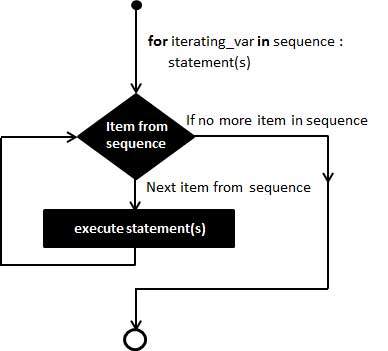The for loop in Python has the ability to iterate over the items of any sequence, such as a list or a string.

Syntax:
The syntax of a for loop look is as follows:for iterating_var in sequence: statements(s)If a sequence contains an expression list, it is evaluated first. Then, the first item in the sequence is assigned to the iterating variable iterating_var. Next, the statements block is executed. Each item in the list is assigned to iterating_var, and the statement(s) block is executed until the entire sequence is exhausted.
Flow Diagram:

Example:
write a programs to print natural number from 1 to n terms.
x = int(raw_input("Enter val :"))for n in range(1,x): print n
Example:
#!/usr/bin/python for letter in 'Python': # First Example print 'Current Letter :', letter fruits = ['banana', 'apple', 'mango'] for fruit in fruits: # Second Example print 'Current fruit :', fruit print "Good bye!"When the above code is executed, it produces the following result:
Current Letter : P Current Letter : y Current Letter : t Current Letter : h Current Letter : o Current Letter : n Current fruit : banana Current fruit : apple Current fruit : mango Good bye!
Iterating by Sequence Index:
An alternative way of iterating through each item is by index offset into the sequence itself. Following is a simple example:#!/usr/bin/python fruits = ['banana', 'apple', 'mango'] for index in range(len(fruits)): print 'Current fruit :', fruits[index] print "Good bye!"When the above code is executed, it produces the following result:
Current fruit : banana Current fruit : apple Current fruit : mango Good bye!Here, we took the assistance of the len() built-in function, which provides the total number of elements in the tuple as well as the range() built-in function to give us the actual sequence to iterate over.
The else Statement Used with Loops
Python supports to have an else statement associated with a loop statement.- If the else statement is used with a for loop, the else statement is executed when the loop has exhausted iterating the list.
- If the else statement is used with a while loop, the else statement is executed when the condition becomes false.
#!/usr/bin/python for num in range(10,20): #to iterate between 10 to 20 for i in range(2,num): #to iterate on the factors of the number if num%i == 0: #to determine the first factor j=num/i #to calculate the second factor print '%d equals %d * %d' % (num,i,j) break #to move to the next number, the #first FOR else: # else part of the loop print num, 'is a prime number'When the above code is executed, it produces the following result:
10 equals 2 * 5 11 is a prime number 12 equals 2 * 6 13 is a prime number 14 equals 2 * 7 15 equals 3 * 5 16 equals 2 * 8 17 is a prime number 18 equals 2 * 9 19 is a prime number
No comments:
Post a Comment